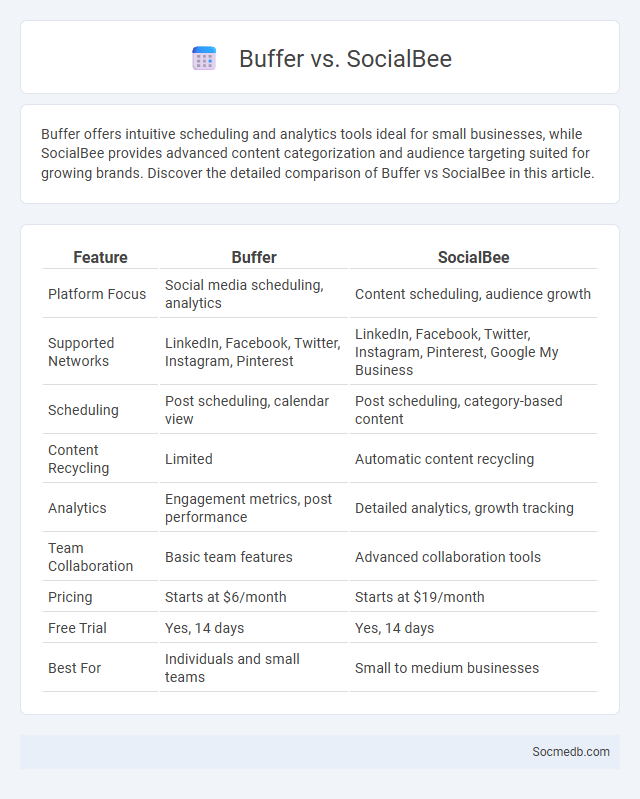
Photo illustration: Buffer vs SocialBee
Buffer offers intuitive scheduling and analytics tools ideal for small businesses, while SocialBee provides advanced content categorization and audience targeting suited for growing brands. Discover the detailed comparison of Buffer vs SocialBee in this article.
Table of Comparison
| Feature | Buffer | SocialBee |
|---|---|---|
| Platform Focus | Social media scheduling, analytics | Content scheduling, audience growth |
| Supported Networks | LinkedIn, Facebook, Twitter, Instagram, Pinterest | LinkedIn, Facebook, Twitter, Instagram, Pinterest, Google My Business |
| Scheduling | Post scheduling, calendar view | Post scheduling, category-based content |
| Content Recycling | Limited | Automatic content recycling |
| Analytics | Engagement metrics, post performance | Detailed analytics, growth tracking |
| Team Collaboration | Basic team features | Advanced collaboration tools |
| Pricing | Starts at $6/month | Starts at $19/month |
| Free Trial | Yes, 14 days | Yes, 14 days |
| Best For | Individuals and small teams | Small to medium businesses |
Introduction to Social Media Management Tools
Social media management tools streamline content scheduling, analytics, and audience engagement across multiple platforms, boosting efficiency and brand presence. These tools offer comprehensive dashboards that help you monitor real-time performance, track competitor activities, and manage customer interactions effectively. Leveraging social media management software enhances your ability to optimize campaigns, increase reach, and drive meaningful engagement with your target audience.
Overview: Buffer, SocialBee, and Content Curation
Buffer streamlines your social media management with an intuitive scheduling interface and robust analytics, supporting multiple platforms like Facebook, Twitter, and Instagram. SocialBee excels in content curation by offering category-based scheduling and recycling evergreen posts to maintain consistent engagement. Integrating content curation tools with scheduling platforms enhances your social media strategy, ensuring timely, relevant posts that boost audience interaction.
Key Features Comparison
Social media platforms vary widely in key features such as content sharing formats, audience reach, and engagement tools. For instance, Instagram emphasizes visual content with photo and video posts, Stories, and Reels, while Twitter prioritizes real-time text updates and trending topics through short tweets and hashtags. LinkedIn stands out for professional networking with features like endorsements, job postings, and industry-specific groups.
User Interface and Ease of Use
Social media platforms are designed with intuitive user interfaces to enhance user engagement and satisfaction. Clear navigation menus, responsive layouts, and customizable settings allow users to interact seamlessly across devices. Ease of use is prioritized through features like simple content creation tools, streamlined messaging systems, and personalized feed algorithms that reduce user effort and increase accessibility.
Content Scheduling Capabilities
Content scheduling capabilities on social media platforms enable businesses to plan, organize, and automate posts across multiple channels, ensuring consistent engagement with target audiences. Tools like Buffer, Hootsuite, and Later provide analytics-driven insights to optimize posting times based on audience activity patterns. Efficient content scheduling improves brand visibility, enhances audience interaction, and supports strategic marketing campaigns by maintaining a steady online presence without manual intervention.
Content Curation and Automation
Content curation streamlines social media strategies by aggregating relevant posts, articles, and multimedia that resonate with target audiences, enhancing engagement and brand authority. Automation tools schedule and distribute curated content efficiently across multiple platforms, ensuring consistent online presence and timely interactions. Leveraging AI-powered algorithms in automation optimizes content delivery based on user behavior and trending topics, maximizing reach and impact.
Analytics and Reporting
Social media analytics and reporting provide essential insights into user engagement, content performance, and audience demographics, enabling data-driven decision-making for your marketing strategies. Advanced tools track key metrics such as reach, impressions, click-through rates, and conversion rates to optimize campaign effectiveness. Regularly analyzing these reports helps you identify trends, adjust tactics, and maximize ROI on social media investments.
Pricing and Plans
Social media platforms offer diverse pricing and plans tailored to different business needs, ranging from free basic accounts to premium subscriptions with advanced analytics and advertising tools. Popular platforms like Facebook, Instagram, and LinkedIn provide tiered plans that include options for small businesses, enterprises, and digital marketers, with pricing often based on features such as reach, audience targeting, and post frequency. Custom plans and pay-as-you-go advertising models enable scalable investment based on campaign goals and budget constraints.
Pros and Cons Summary
Social media platforms enhance communication by connecting billions worldwide, facilitating real-time information sharing and community building. They offer significant marketing advantages, enabling targeted advertising and brand exposure but also pose risks such as misinformation spread and privacy breaches. User engagement on social media can boost creativity and support networks, yet excessive use may lead to mental health challenges like anxiety and decreased attention spans.
Which Tool Is Best for Your Business?
Choosing the best social media tool for your business depends on your specific goals, target audience, and content strategy. Platforms like Instagram excel in visual branding for lifestyle and retail businesses, while LinkedIn is ideal for B2B networking and professional services. Analyzing engagement metrics and demographic data on each platform helps determine the most effective tool to maximize reach and ROI.
 socmedb.com
socmedb.com